"doc. scientifico-turistico"/scientific-tourist documentary
One of the first examples of 16mm sound —Cinegiornale, 1936
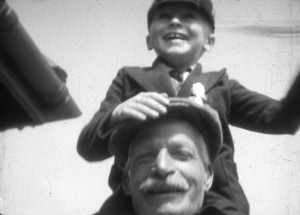
"Made by local amateur filmmaker Charles Scott, the film documents civic and public life in Norwich leading up to World War II and immediately following its conclusion. Beginning in 1933, Scott records acrobats, tightrope walkers and trapeze artists at the Norwich Carnival. The 1933 Armistice Parade features soldiers marching through the streets, halting at the eleventh hour. In 1934, Scott shows the Lord Mayor's Sunday celebrations at the Cathedral, as well as highlights from that year's Carnival. In 1935, Norwich celebrates the silver jubilee of King George V with decorations, parades, a military salute and an air display. January 1936 sees Norwich City Football Club taking on Chelsea in an FA Cup match at the newly built Carrow Road Stadium, with Scott capturing some of the action from his position behind the goal at the River End. Later that year, Scott returns to the Norwich Carnival once again, this time to catch an appearance by Hollywood starlet June Clyde. Norwich celebrates the coronation of King George VI with an extravagant street procession in May 1937. In 1938, with Britain gearing up for war, the Air Raid Precautions team practise fire-fighting and rescues, and test a new extension ladder. Following a break for wartime service, Scott returns to his film in 1946, documenting Battle of Britain Week by visiting the graves of servicemen and recording celebrations and parades in Norwich. Scott's film concludes with a visit to the home of prize-winning model engineer W.F.A. Way, who demonstrates some of his models on his garden track" (EAFA Database).
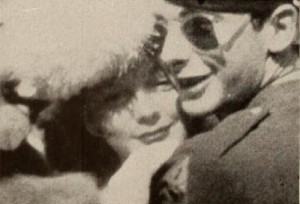
"An eye for topical touches and a persistence that would shame the most aggressive news cameraman are responsible for Terry Manos's success in recording the V-E Day activities in New York City. Without the aid of a telephoto lens and balked at every turn by finicking guards, Mr. Manos's camera nevertheless caught the full flavor of the celebration in Times Square as well as some amazingly sharp studies of the personalities who participated in the program at Central Park. For ignoring the theoretical limitations often ascribed to the 8mm. camera and producing a well knit movie of a great historical event, praise is due to an enterprising amateur." Movie Makers, Dec. 1946, 488.
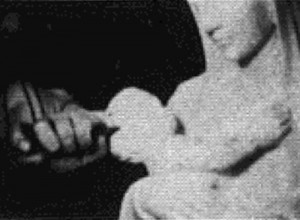
"The film opens in Florence, Italy, with the statue of David by Michelangelo, in marble. Then we quickly move to the quarry to observe the processes of opening a crack, part of the process of shearing off a piece from the huge mountain of marble. Later we see the cutting and slicing into useful slabs and polishing. Also, we visit a studio where, among other works, a large block of marble is being carved into a statue of Abraham Lincoln for the city of Boston. The commentary on tape is well done. This will be included in the Package" PSA Journal, Oct. 1962, 33.
"documentario"/documentary -
"un complesso vivace e policromo di visioni del paesaggio e della vita di Albania"—"I Littoriali del cinema: Un’altra interessante serie di documentari,” La Stampa, September 3, 1939
"...a lively, polychromatic complex of visions of Albania's landscape and life."
documentario/documentary
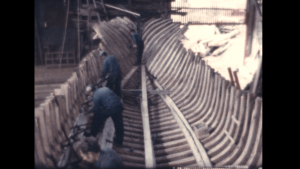
Construcción artesanal de barcos en los astilleros de Lekeitio.
Handcrafted construction of ships in the shipyards of Lekeitio.
Jami is a black-and-white film about beautiful girls that are actually the International Playboys, a well known singing and dancing group of three young men, in seven minutes, Larry Zazelenchuk of Sudbury, Ontario, shows us how the boys make-up to be some of the prettiest girls you have ever seen. In their conversation during make-up in the dressing room the boys leave no doubt about the fact this is not another film about homosexuals. This is strictly show business, well filmed and, certainly, an unusual subject,"PSA Journal, Mar. 1970, 43-44.
"Renowned Hungarian violinist Jelly D'Aranyi steals the scene, and brings a swirl of glamour to a cold Manchester day, as she entertains young Ruth Behrens in the family's garden. Jelly always stayed at Holly Royde, the Behrens' family home, when she performed with the Halle Orchestra. Look out for Ruth's sister Mary, confined to the house with a cold, and watching the fun through opera glasses." (BFI Player)
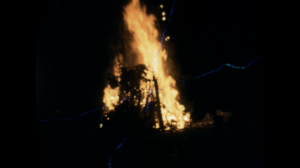
PNV-k egin zituen ahaleginak propiedadiak berreskuratzeko.
El filme muestra los esfuerzos del Partido Nacionalista Vasco por recuperar bienes.
The film depicts the efforts made by the Basque Nationalist Party to recover assets.
Total Pages: 79